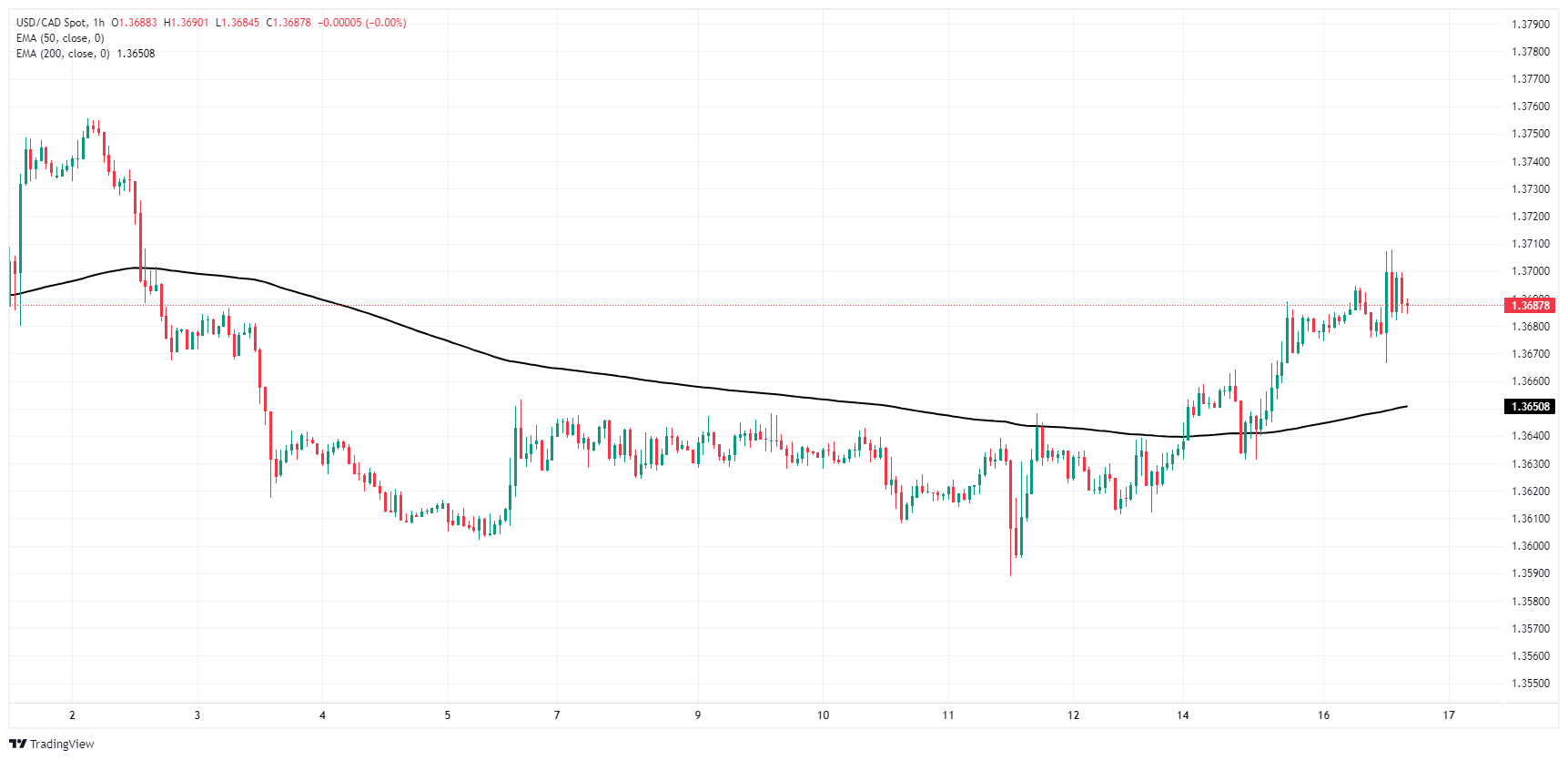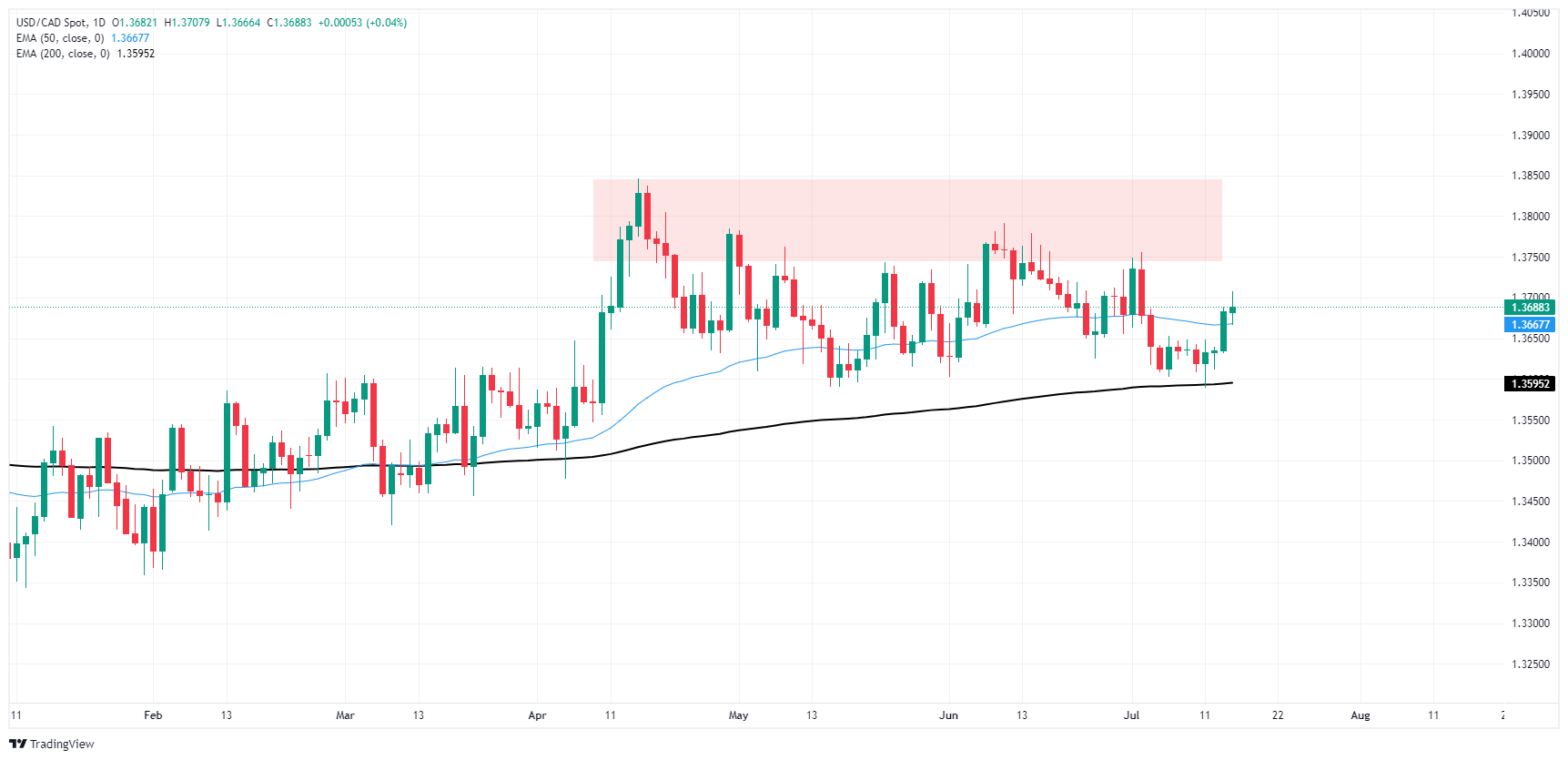- Phân tích
- Tin tức và các công cụ
- Tin tức thị trường
- Canadian Dollar struggles to find direction on Tuesday after mixed Canadian CPI inflation print
Canadian Dollar struggles to find direction on Tuesday after mixed Canadian CPI inflation print
- Canadian Dollar went sideways after misfire in Canadian CPI inflation.
- Canada reported a downturn in near-term CPI, but BoC YoY CPI ticked up.
- US Retail Sales print kicks off a fresh round of rate cut hopes.
The Canadian Dollar (CAD) went sideways on Tuesday after CAD traders found little reason to bid too firmly in either direction after a mixed Canadian Consumer Price Index (CPI) inflation print. US data dominated market focus, with a soft print driving broad-market bets of a September rate cut even higher.
With Canadian CPI inflation out of the way, the next data beat worth focusing on for CAD traders will be Friday’s upcoming Canadian Retail Sales. Median market forecasts expect a return to contraction territory in monthly figures after June data recovered from a three-month streak of negative Canadian Retail Sales growth.
Daily digest market movers: Canadian Dollar furrowed by lopsided CPI print, Fed rate cut bets max out
- Headline Canadian CPI inflation in June contracted -0.1% MoM versus the previous 0.6%, missing the forecast slowdown to 0.1%.
- Annualized Canadian CPI eased to 2.7% from the previous 2.9%.
- The Bank of Canada’s (BoC) own CPI inflation gauge likewise fell to -0.1% from 0.6% MoM, while the YoY figure accelerated to 1.9% from the previous 1.8%.
- US Retail Sales fell flat in June, printing at the expected 0.0% MoM compared to the previous month’s 0.3% (revised from 0.1%).
- With a steeper-than-expected decline post-revision, market bets of a Federal Reserve (Fed) rate cut in September have been pinned to the ceiling.
- Rate traders are pricing in 100% odds of at least a quarter-point rate trim in September, according to the CME’s FedWatch Tool.
Canadian Dollar PRICE Today
The table below shows the percentage change of Canadian Dollar (CAD) against listed major currencies today. Canadian Dollar was the strongest against the New Zealand Dollar.
| USD | EUR | GBP | JPY | CAD | AUD | NZD | CHF | |
|---|---|---|---|---|---|---|---|---|
| USD | 0.09% | 0.11% | 0.30% | 0.03% | 0.54% | 0.60% | -0.09% | |
| EUR | -0.09% | 0.01% | 0.22% | -0.04% | 0.43% | 0.50% | -0.19% | |
| GBP | -0.11% | -0.01% | 0.21% | -0.05% | 0.42% | 0.48% | -0.17% | |
| JPY | -0.30% | -0.22% | -0.21% | -0.28% | 0.26% | 0.29% | -0.34% | |
| CAD | -0.03% | 0.04% | 0.05% | 0.28% | 0.51% | 0.56% | -0.09% | |
| AUD | -0.54% | -0.43% | -0.42% | -0.26% | -0.51% | 0.04% | -0.62% | |
| NZD | -0.60% | -0.50% | -0.48% | -0.29% | -0.56% | -0.04% | -0.65% | |
| CHF | 0.09% | 0.19% | 0.17% | 0.34% | 0.09% | 0.62% | 0.65% |
The heat map shows percentage changes of major currencies against each other. The base currency is picked from the left column, while the quote currency is picked from the top row. For example, if you pick the Canadian Dollar from the left column and move along the horizontal line to the US Dollar, the percentage change displayed in the box will represent CAD (base)/USD (quote).
Technical analysis: Canadian Dollar flattens amid a mild uptick in intraday volatility
The Canadian Dollar (CAD) found some chart churn on Tuesday, but struggled to develop any meaningful momentum as CAD traders failed to find a reason to push the needle too far in either direction. The CAD is trading within one-tenth of one percent against its major competitors the US Dollar (USD), Euro (EUR), and Pound Sterling (GBP), while gains of around one-half of one percent against the Australian Dollar (AUD) and the New Zealand Dollar (NZD) were owed to weakness in the Antipodeans.
USD/CAD continued to battle the 1.3700 handle as broad-market bidding bolstered the Greenback. Intraday momentum has evaporated into a choppy standstill just beneath the key handle as bidders struggle to push the pair into further gains after last week’s recovery from a swing low below 1.3600.
USD/CAD hourly chart
USD/CAD daily chart
Canadian Dollar FAQs
The key factors driving the Canadian Dollar (CAD) are the level of interest rates set by the Bank of Canada (BoC), the price of Oil, Canada’s largest export, the health of its economy, inflation and the Trade Balance, which is the difference between the value of Canada’s exports versus its imports. Other factors include market sentiment – whether investors are taking on more risky assets (risk-on) or seeking safe-havens (risk-off) – with risk-on being CAD-positive. As its largest trading partner, the health of the US economy is also a key factor influencing the Canadian Dollar.
The Bank of Canada (BoC) has a significant influence on the Canadian Dollar by setting the level of interest rates that banks can lend to one another. This influences the level of interest rates for everyone. The main goal of the BoC is to maintain inflation at 1-3% by adjusting interest rates up or down. Relatively higher interest rates tend to be positive for the CAD. The Bank of Canada can also use quantitative easing and tightening to influence credit conditions, with the former CAD-negative and the latter CAD-positive.
The price of Oil is a key factor impacting the value of the Canadian Dollar. Petroleum is Canada’s biggest export, so Oil price tends to have an immediate impact on the CAD value. Generally, if Oil price rises CAD also goes up, as aggregate demand for the currency increases. The opposite is the case if the price of Oil falls. Higher Oil prices also tend to result in a greater likelihood of a positive Trade Balance, which is also supportive of the CAD.
While inflation had always traditionally been thought of as a negative factor for a currency since it lowers the value of money, the opposite has actually been the case in modern times with the relaxation of cross-border capital controls. Higher inflation tends to lead central banks to put up interest rates which attracts more capital inflows from global investors seeking a lucrative place to keep their money. This increases demand for the local currency, which in Canada’s case is the Canadian Dollar.
Macroeconomic data releases gauge the health of the economy and can have an impact on the Canadian Dollar. Indicators such as GDP, Manufacturing and Services PMIs, employment, and consumer sentiment surveys can all influence the direction of the CAD. A strong economy is good for the Canadian Dollar. Not only does it attract more foreign investment but it may encourage the Bank of Canada to put up interest rates, leading to a stronger currency. If economic data is weak, however, the CAD is likely to fall.
© 2000-2024. Bản quyền Teletrade.
Trang web này được quản lý bởi Teletrade D.J. LLC 2351 LLC 2022 (Euro House, Richmond Hill Road, Kingstown, VC0100, St. Vincent and the Grenadines).
Thông tin trên trang web không phải là cơ sở để đưa ra quyết định đầu tư và chỉ được cung cấp cho mục đích làm quen.
Giao dịch trên thị trường tài chính (đặc biệt là giao dịch sử dụng các công cụ biên) mở ra những cơ hội lớn và tạo điều kiện cho các nhà đầu tư sẵn sàng mạo hiểm để thu lợi nhuận, tuy nhiên nó mang trong mình nguy cơ rủi ro khá cao. Chính vì vậy trước khi tiến hành giao dịch cần phải xem xét mọi mặt vấn đề chấp nhận tiến hành giao dịch cụ thể xét theo quan điểm của nguồn lực tài chính sẵn có và mức độ am hiểu thị trường tài chính.
Sử dụng thông tin: sử dụng toàn bộ hay riêng biệt các dữ liệu trên trang web của công ty TeleTrade như một nguồn cung cấp thông tin nhất định. Việc sử dụng tư liệu từ trang web cần kèm theo liên kết đến trang teletrade.vn. Việc tự động thu thập số liệu cũng như thông tin từ trang web TeleTrade đều không được phép.
Xin vui lòng liên hệ với pr@teletrade.global nếu có câu hỏi.















